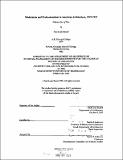Modernism and professionalism in American architecture, 1919-1933
Author(s)
Bentel, Paul.
DownloadFull printable version (83.73Mb)
Advisor
Stanford Anderson.
Terms of use
Metadata
Show full item recordAbstract
This dissertation examines the dominant conventions of architectural practice in the United States between 1919 and 1933. It proceeds from two assumptions: first, that by the 1900s, both the American Institute of Architects (AlA) and the numerous professional journals available to architects across the country solidified the profession nationally and yielded a coherent field within which practitioners could debate the content of their professional service; second, that within the context of its national discourse, the architecture profession drew inspiration for its effort to identify a social function for itself from the White City Movement which forged a link between the architect and a national political, industrial and cultural leadership drawn together by American Progressivism. The study focuses on the period following the demise of the White City Movement during which American architects cast off their allegiance to its traditional aesthetic formulae but retained the aspiration to associate themselves and their work with prevailing trends in a national political and social milieu. It demonstrates that in their efforts to redefine the terms of their professional service, American architects invoked the popular terminology of Scientific Management, Technocracy, Fordism, and the nostrums of the 'New Era' and promised 'efficiency' in their work and in the industries they presumed to manage. It reveals that within these efforts of professional redefinition, the professional ideology supporting the architect's aspirations for work converged with a modernist idealism espousing the value of technical expertise as a medium of social emancipation and progress. By giving evidence of a widespread and indigenous modernism that perceived a social benefit in the architect's capacity to utilize industrial technology, this project amends the dominant historical view which attributes the re-emergence of an American Modem Movement in the 1930s to the 'diaspora' of European artists and intellectuals before to WW II. This study has two parts. In Part One, it examines first the canons of Beaux-Arts Classicism and their gradual dissolution after World War I under the pressure of criticism from writers such as Ralph Adams Cram, Louis Sullivan and Lewis Mumford and through the work of the AlA's PostWar Committee; and second, the institutional structure of the AlA and its organizational ideologies in the 1920s. In Part Two, it looks more closely at the evolving conventions of professional service, demonstrating that American architects reached a consensus about the necessity of a 'new' architecture which identified itself in three areas: first, in its rejection of the Beaux-Arts method of interpreting a building program through a stylistic rendition of its social 'character' in favor of design strategies that maximized usable space; second, in its abandonment of the visual paradigm of the White City in favor of the expansionist rhetoric of Regional Planning; and third, in its disavowal of stylistic conventions based on historical precedent in favor of styles that both demonstrated a discontinuity with the past and celebrated an evolving consumerist 'utopia' populated by industrial commodities.
Description
Thesis (Ph. D. in Architecture and Environmental Studies)--Massachusetts Institute of Technology, Dept. of Architecture, 1993. Vita. Includes bibliographical references (v. 2, p. 371-395).
Date issued
1993Department
Massachusetts Institute of Technology. Department of Architecture; Massachusetts Institute of Technology. Department of Urban Studies and PlanningPublisher
Massachusetts Institute of Technology
Keywords
Architecture, Urban Studies and Planning